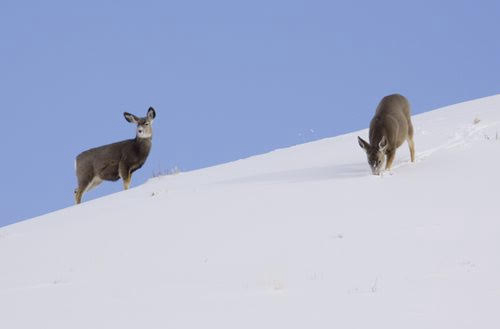Winter’s Groceries – Improve your Herd’s Health through Late Winter Food By Austin Delano
 It is a widely accepted fact, with plenty of research to back it up, that high quality protein is essential during antler growth and fawn rearing season for your deer to express their genetic potential. However, one area that is often overlooked for year-round nutrition is during the late winter and early spring. Hunters have a tendency to hang-up the rifle when the season is over and not think about their deer again for months. The late winter/early spring time period can be stressful for your entire herd, not just the rut weary bucks. Having a dependable, quality food source during this critical time is a must if you wish to make sure worn out bucks, as well as does that are now pregnant, can enter the spring in great health and body condition. I don’t think it would be a surprise to anyone that a deer entering the spring antler growing period still playing catch up, is NOT going to grow his best rack or increase in body size. Providing late season food is not all about antlers either, but rather the overall health of the entire herd.
It is a widely accepted fact, with plenty of research to back it up, that high quality protein is essential during antler growth and fawn rearing season for your deer to express their genetic potential. However, one area that is often overlooked for year-round nutrition is during the late winter and early spring. Hunters have a tendency to hang-up the rifle when the season is over and not think about their deer again for months. The late winter/early spring time period can be stressful for your entire herd, not just the rut weary bucks. Having a dependable, quality food source during this critical time is a must if you wish to make sure worn out bucks, as well as does that are now pregnant, can enter the spring in great health and body condition. I don’t think it would be a surprise to anyone that a deer entering the spring antler growing period still playing catch up, is NOT going to grow his best rack or increase in body size. Providing late season food is not all about antlers either, but rather the overall health of the entire herd.
Cold Weather Plants
As the hunting season winds down and the cold weather sets in, whitetails are on their feet and in need of a high energy, high carbohydrate food source. Planting a late season annual such as brassicas can help carry your herd through the tough months. One of the most effective ways to keep deer on a property is to have a destination feeding field that is seldom if ever hunted. Brassica blends such as Maximum, Deer Radish or Winter Bulbs & Sugar Beets, containing plants with staggered maturity and palatability dates are ideal for this task. After your cereal grains and clovers have been browsed down and covered in snow, brassicas are very attractive and highly preferred by whitetails. Seeing deer dig through heavy snow to reach a plot filled with thick-leaved greens is a sight any food plot farmer loves to see.
Why Brassica?
Brassicas are a genus of plants containing many cultivars that whitetails love. These include rape, sugar beets, radishes and turnips to name a few. They have the potential to provide a lot of forage in a short growing season and can yield many tons of forage per acre. Brassicas offer great browse tolerance since they are not usually preferred by deer until cooler weather changes the chemistry of the plants to their most palatable stage. Many hunters say that after their first or second hard freeze, their brassica plots become the preferred food source, even over corn or beans. Planting brassicas at the right time of year is critical to get the most out of the plant from a tonnage standpoint, but not planting so early that the plants get too rank and mature making them less attractive and palatable, and possibly bolting to flower and seed.
Proof is in the Green
Throughout the year we get many communications with great stories from managers with a new found love for brassicas. The weekends and long days on tractors and ATV’s are greatly rewarded with a field full of lush green plants that their deer are ravaging. Many of the same people talk about increasing the amount of acreage they will plant in brassicas the following year. While cereal grains such as wheat and oats are highly attractive to deer, if they are the only plot available on your property there could be a gap in available food late in the season.
If your plots are eaten down to almost bare dirt by the end of the season, less deer or increased plot acreage is in order…maybe both. Similar to getting the best potential out of your summer plots for antler growth, overwhelming your deer with late season food pays off big time. A lack of a dependable late winter food source could cause your deer to stray off your land to the closest neighbor with something to provide. Every year we receive pictures of mature bucks that were killed in a Maximum or Deer Radish field, proving that highly attractive late season food will get bucks on their feet and in the open during daylight hours.
Supplemental Feeding
Although food plots are a great way to help with late winter/early spring nutrition there may be situations where your plots didn’t perform or grow a lot of tonnage due to drought, lack of available food plot acreage or a late planting. Supplemental feeding is a great way to compliment and fill any gaps in your food plot program and ensure the availability of quality nutrition during the late winter and early spring.
Before we go any further let’s clarify a few things – to truly supplement a deer herd with feed, the deer must be offered the feed in a free choice fashion, be it through a trough or an extended tube type feeder. Feeding protein through spinner type feeders, therefore not making the protein available at anytime, IS more beneficial than feeding corn; however, maximum results come from feeding a quality protein feed free-choice. Supplemental feeding, when combined with high protein and carbohydrate levels found in late winter/early spring plots, is a two-sided approach that will ensure bucks regain body condition post-rut in preparation for the next antler growing season.
How Much Do I Need to Feed?
As is the case with many other wildlife management questions, “how much to feed” depends on a few variables. Deer density, available native forage and its quality, as well as total acreage in food plots will all play a part in determining how much you will need to feed. A good starting point is to establish a feeding station for every 25 deer on your property. If you are unsure of deer densities in your area contact a local state biologist and he or she will provide you with local survey data that can be used to calculate deer densities on your property. There are also simple formulas for camera surveys that can be run on a property to help determine deer density and buck to doe ratio. A good rule of thumb is to have a feeding station for every 80-100 acres of land being managed.
If you are just starting a feeding program on your property many times deer will be reluctant to consume feed at first. As with some food plots with new plants in them, supplemental feed is a new smell, taste, and texture than anything they have had before and it may take some time to condition your herd to eating from a feeder. A great way to get deer started on supplemental feed and a feeding station is to start off with corn or Golden Deer Nuggets. As the deer begin to frequent the feeder, you can gradually introduce protein pellets at an increased ratio every time you fill the feeder until you are feeding 100% pellets.
What to Feed?
With the popularity of supplemental feeding with protein pellets increasing, there are many options for wildlife managers. Record Rack Sportsman deer feeds are tailor-made for the manager looking to supplement their native habitat and food plots to support superior antler growth and body condition in their herd. Record Rack has several feed options available whether you are the weekend warrior trying to improve your herd at the family farm, or managing several thousand acres with numerous feeders. My personal favorite is their Professional blend with 20% protein. I have fed quite a few pallets of it over the years and have seen firsthand the difference in a deer herd with and without supplemental feed.
Feeders
There are a wide variety of feeders available on the market today. The majority are spin feeders on timers. These can work for properties in the drier climates such as Texas, Oklahoma, etc. The downside to these feeders is their small capacity (which means frequent trips to fill up) and some waste, mostly to unwanted critters. In areas with more frequent rainfall and high humidity, I have found free choice trough feeders or bulk gravity flow models to be utilized best by deer, as well as being the most trouble free.
Trough feeders can be built in many different ways to suit whatever needs you have specific to your property. I like to build them on 4”x6”s on the bottom with one end cut at an angle so a chain or strap can be attached and easily moved with an ATV. The bottom of the trough where the feed will actually sit can be constructed from marine grade plywood to resist mildew and mold and be very moisture resistant. Trough feeders should also be built with treated lumber so they will stand up to the weather for many years. Second hand metal can be used for the roof to ensure the feed stays dry and fresh. When building your feeder, make sure the roof is high enough so a buck in velvet won’t bump his rack on it.
Many absentee landowners find it advantageous to use the large tube style free choice bulk feeders. They can hold a lot of feed and keep it fresh for extended periods of time. These are generally constructed of heavy duty metal and can hold a couple hundred pounds up to a couple of tons of feed. The gravity flow tubes are harder for unwanted pests like raccoons to get to as well.
Gamekeepers who have taken a few extra steps in preparation for the hard times of the post rut and tough, cold winters have seen the benefits that improving body condition can have on antler growth the following year. Keep in mind that supplementation whether through planting plots, supplemental feeding, or a combination of both, are by no means a fix for poor habitat management or out of control high deer densities. We cannot feed or plant our way out of problems associated with improper herd and habitat management. However, combined with sound herd management strategies, proper wintertime nutrition can help your herd achieve their proper potential.
Would you like to learn more about improving your hunting and get discounts on the products you need? Learn from the experts by joining the new Mossy Oak GameKeepers Club at www.gamekeepersclub.com. Or call 844-256-4645.






